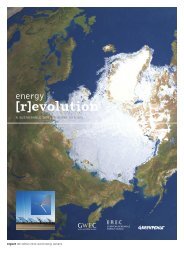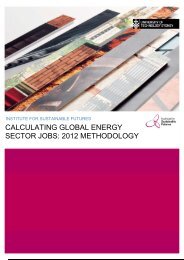download the mexico energy revolution scenario
download the mexico energy revolution scenario
download the mexico energy revolution scenario
Create successful ePaper yourself
Turn your PDF publications into a flip-book with our unique Google optimized e-Paper software.
WORLD ENERGY [R]EVOLUTION<br />
A SUSTAINABLE ENERGY OUTLOOK<br />
6<br />
key results | HEATING AND COOLING SUPPLY<br />
figure 6.2: development of electricity demand by sector<br />
(REF, E[R] & advanced E[R])<br />
3,500<br />
3,000<br />
2,500<br />
2,000<br />
1,500<br />
1,000<br />
500<br />
PJ/a 0<br />
E[R] adv<br />
E[R]<br />
E[R] adv<br />
E[R]<br />
2007 2010<br />
‘EFFICIENCY’<br />
OTHER SECTORS<br />
• INDUSTRY<br />
TRANSPORT<br />
E[R] adv<br />
E[R]<br />
2020<br />
E[R] adv<br />
E[R]<br />
2030<br />
E[R] adv<br />
E[R]<br />
2040<br />
E[R] adv<br />
E[R]<br />
2050<br />
heating and cooling supply<br />
Today, renewables meet 19% of Mexico’s primary <strong>energy</strong> demand<br />
for heat supply, <strong>the</strong> main contribution coming from <strong>the</strong> use of<br />
biomass. The lack of district heating networks is a severe structural<br />
barrier to <strong>the</strong> large scale utilisation of geo<strong>the</strong>rmal and solar<br />
<strong>the</strong>rmal <strong>energy</strong>. Dedicated support instruments are required to<br />
ensure a dynamic development.<br />
In <strong>the</strong> Energy [R]evolution <strong>scenario</strong>, renewables provide 68% of<br />
Mexico’s total heating demand by 2050.<br />
• Energy efficiency measures help to reduce <strong>the</strong> currently growing<br />
demand for heating and cooling, in spite of improving living standards.<br />
• In <strong>the</strong> industry sector solar collectors, biomass/biogas and<br />
geo<strong>the</strong>rmal <strong>energy</strong> are increasingly substituted for conventional<br />
fossil-fuelled heating systems.<br />
• A shift from coal and oil to natural gas in <strong>the</strong> remaining conventional<br />
applications leads to a fur<strong>the</strong>r reduction of CO2 emissions.<br />
In <strong>the</strong> Energy [R]evolution <strong>scenario</strong> 988 PJ/a is saved by 2050, or<br />
31% compared to <strong>the</strong> Reference <strong>scenario</strong>. The advanced version<br />
introduces renewable heating systems around five years ahead of<br />
<strong>the</strong> basic <strong>scenario</strong>. Solar collectors and geo<strong>the</strong>rmal heating systems<br />
achieve economies of scale via ambitious support programmes five<br />
to ten years earlier, resulting in a renewables share of 55% by<br />
2030 and 88% by 2050.<br />
figure 6.3: development of heat demand by sector<br />
figure 6.4: development of heat supply structure under<br />
3 <strong>scenario</strong>s<br />
3,500<br />
3,000<br />
2,500<br />
2,000<br />
1,500<br />
1,000<br />
500<br />
3,500<br />
3,000<br />
2,500<br />
2,000<br />
1,500<br />
1,000<br />
500<br />
PJ/a 0<br />
PJ/a 0<br />
E[R] adv<br />
E[R]<br />
2007<br />
• ‘EFFICIENCY’<br />
E[R] adv<br />
E[R]<br />
2010<br />
E[R] adv<br />
E[R]<br />
2020<br />
E[R] adv<br />
E[R]<br />
2030<br />
E[R] adv<br />
E[R]<br />
2040<br />
E[R] adv<br />
E[R]<br />
2050<br />
REF E[R] adv<br />
E[R]<br />
REF E[R] adv<br />
E[R]<br />
REF E[R] adv<br />
E[R]<br />
REF E[R] adv<br />
E[R]<br />
REF E[R] adv<br />
E[R]<br />
REF E[R] adv<br />
E[R]<br />
2007 2015 2020 2030 2040 2050<br />
OTHER SECTORS<br />
• INDUSTRY<br />
• ‘EFFICIENCY’<br />
HYDROGEN<br />
GEOTHERMAL<br />
SOLAR<br />
• BIOMASS<br />
FOSSIL FUELS<br />
60



![Energy [R]evolution - European Commission](https://img.yumpu.com/49109324/1/184x260/energy-revolution-european-commission.jpg?quality=85)


![5905 gp [eu rev]csfr4.qxd - Energy [R]evolution](https://img.yumpu.com/42305023/1/184x260/5905-gp-eu-revcsfr4qxd-energy-revolution.jpg?quality=85)


![5905 gp [eu rev]csfr4.qxd - Energy [R]evolution](https://img.yumpu.com/28729264/1/184x260/5905-gp-eu-revcsfr4qxd-energy-revolution.jpg?quality=85)